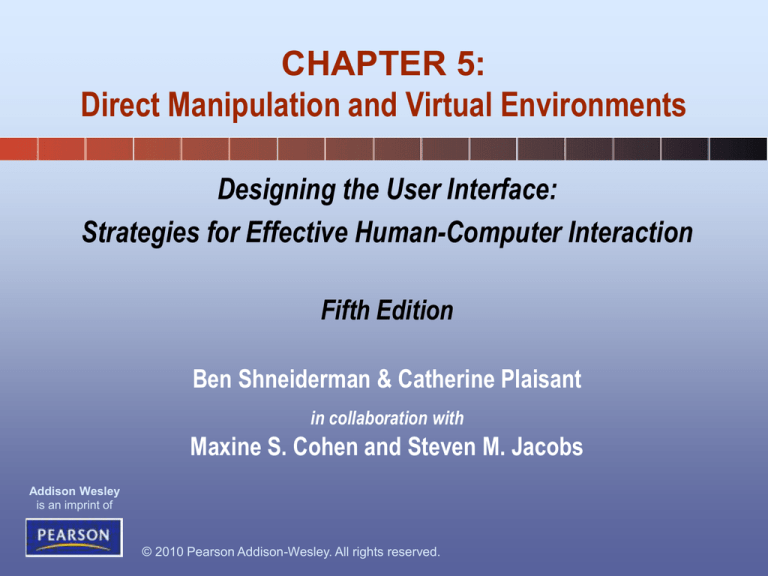
CHAPTER 5:
Direct Manipulation and Virtual Environments
Designing the User Interface:
Strategies for Effective Human-Computer Interaction
Fifth Edition
Ben Shneiderman & Catherine Plaisant
in collaboration with
Maxine S. Cohen and Steven M. Jacobs
Addison Wesley
is an imprint of
© 2010 Pearson Addison-Wesley. All rights reserved.
Introduction
• Positive feelings associated with good user
interfaces:
– Mastery of the interface
– Competence in performing tasks
– Ease in learning the system originally and in
assimilating advanced features
– Confidence in the capacity to retain mastery over time
– Enjoyment in using the system
– Eagerness to show the system off to novices
– Desire to explore more powerful aspects of the system
1-2
© 2010 Pearson Addison-Wesley. All rights reserved.
6-2
Examples of
Direct-Manipulation Systems
Command line vs. display editors and word processors
• Training times with display editors are much less than line editors
• Line editors are generally more flexible and powerful
• The advances of WYSIWYG word processors:
– Display a full page of text
– Display of the document in the form that it will appear when the
final printing is done
– Show cursor action
– Control cursor motion through physically obvious and intuitively
natural means
– Use of labeled icon for actions
– Display of the results of an action immediately
– Provide rapid response and display
– Offer easily reversible actions
1-3
© 2010 Pearson Addison-Wesley. All rights reserved.
6-3
Examples of
Direct-Manipulation Systems:
WYSIWYG word processing
1-4
© 2010 Pearson Addison-Wesley. All rights reserved.
6-4
Examples of Direct-Manipulation
Systems (cont.)
Technologies that derive from the word processor:
• Integration
• Desktop publication software
• Slide-presentation software
• Hypermedia environments
• Improved macro facilities
• Spell checker and thesaurus
• Grammar checkers
1-5
© 2010 Pearson Addison-Wesley. All rights reserved.
6-5
Examples of Direct-Manipulation
Systems (cont.)
The VisiCalc spreadsheet and its descendants
• VisiCalc users delighted in watching the program
propagate changes across the screen.
• In some cases, spatial representations provide a better
model of reality
• Successful spatial data-management systems depend on
choosing appropriate:
– Icons
– Graphical representations
– Natural and comprehensible data layouts
1-6
© 2010 Pearson Addison-Wesley. All rights reserved.
6-6
Examples of Direct-Manipulation
Systems (cont.): spreadsheet
1-7
© 2010 Pearson Addison-Wesley. All rights reserved.
6-7
Examples of Direct-Manipulation
Systems (cont.)
spatial data management
1-8
© 2010 Pearson Addison-Wesley. All rights reserved.
6-8
Examples of Direct-Manipulation
Systems (cont.)
Video games
• Nintendo Wii, Sony PlayStation, and Microsoft Xbox
• Field of action is visual and compelling
• Commands are physical actions whose results are immediately
shown on the screen
• No syntax to remember
• Most games continuously display a score
• Direct manipulation in SimSity
• Second Life virtual world
• Spore
• Myst well received
• DOOM and Quake controversial
1-9
© 2010 Pearson Addison-Wesley. All rights reserved.
6-9
Examples of Direct-Manipulation
Systems (cont.)
Guitar Hero video game
1-10
© 2010 Pearson Addison-Wesley. All rights reserved.
6-10
Examples of Direct-Manipulation
Systems (cont.)
Computer-aided design
•
•
•
•
•
Computer-aided design (CAD) use direct manipulation
Manipulate the object of interest
Generate alternatives easily
Explain the impact
Problem solving by analogy to the real-world
Office automation
•
•
•
•
Xerox Star was a pioneer with sophisticated formatting
Apple Lisa System
Rapid and continuous graphical interaction
Microsoft Windows is a descendant
1-11
© 2010 Pearson Addison-Wesley. All rights reserved.
6-11
Continuing evolution of DirectManipulation Systems
Direct-Manipulation interfaces are being used in a wide range of
applications, e.g. management dashboard for a retail store
1-12
© 2010 Pearson Addison-Wesley. All rights reserved.
6-12
Continuing evolution of DirectManipulation Systems (cont.)
1-13
© 2010 Pearson Addison-Wesley. All rights reserved.
6-13
Discussion of Direct
Manipulation
Problems with direct manipulation
• Spatial or visual representations can be too spread out
• High-level flowcharts and database-schema can become
confusing
• Designs may force valuable information off of the screen
• Users must learn the graphical representations
• The visual representation may be misleading
• Typing commands with the keyboard may be faster
1-14
© 2010 Pearson Addison-Wesley. All rights reserved.
6-14
Principles of Direct Manipulation
1. Continuous representations of the objects and
actions of interest with meaningful visual
metaphors.
2. Physical actions or presses of labeled buttons,
instead of complex syntax.
3. Rapid, incremental, reversible actions whose
effects on the objects of interest are visible
immediately.
1-15
© 2010 Pearson Addison-Wesley. All rights reserved.
6-15
Interface-Building Tools
Visual Thinking and Icons
•
The visual nature of computers can challenge the
first generation of hackers
An icon is an image, picture, or symbol representing
a concept
Icon-specific guidelines
•
•
–
–
–
–
–
–
–
–
Represent the object or action in a familiar manner
Limit the number of different icons
Make icons stand out from the background
Consider three-dimensional icons
Ensure a selected icon is visible from unselected icons
Design the movement animation
Add detailed information
Explore combinations of icons to create new objects or
actions
© 2010 Pearson Addison-Wesley. All rights reserved.
1-16
6-16
3D Interfaces
• “Pure” 3D interfaces have strong utility in some contexts,
e.g., medical, product design. In other situations, more
constrained interaction may actually be preferable to
simplify interactions.
• “Enhanced” interfaces, better than reality, can help
reduce the limitations of the real-world, e.g., providing
simultaneous views.
• Avatars in multiplayer 3-D worlds
• First person games
1-17
© 2010 Pearson Addison-Wesley. All rights reserved.
6-17
3D Interfaces (cont.)
1-18
© 2010 Pearson Addison-Wesley. All rights reserved.
6-18
3D Interfaces (cont.)
Features for effective 3D
–
–
–
–
–
–
–
–
–
Use occlusion, shadows, perspective, and other 3D techniques
carefully.
Minimize the number of navigation steps for users to
accomplish their tasks.
Keep text readable.
Avoid unnecessary visual clutter, distraction, contrast shifts, and
reflections.
Simplify user movement.
Prevent errors.
Simplify object movement
Organize groups of items in aligned structures to allow rapid
visual search.
Enable users to construct visual groups to support spatial recall.
© 2010 Pearson Addison-Wesley. All rights reserved.
1-19
6-19
3D Interfaces (cont.)
Guidelines for inclusion of enhanced 3D features:
– Provide overviews so users can see the big picture
– Allow teleoperation
– Offer X-ray vision so users can see into or beyond
objects.
– Provide history keeping
– Permit rich user actions on objects
– Enable remote collaboration
– Give users control over explanatory text and let users
select for details on demand.
– Offer tools to select, mark, and measure.
1-20
© 2010 Pearson Addison-Wesley. All rights reserved.
6-20
3D Interfaces (cont.)
Guidelines for inclusion of enhanced 3D features
(cont.):
– Implement dynamic queries to rapidly filter out
unneeded items.
– Support semantic zooming and movement
– Enable landmarks to show themselves even at a
distance
– Allow multiple coordinated views
– Develop novel 3D icons to represent concepts that are
more recognizable and memorable.
1-21
© 2010 Pearson Addison-Wesley. All rights reserved.
6-21
Teleoperation
• Two “parents”: direct manipulation in personal
computers and process control in complex environments
• Physical operation is remote
• Complicating factors in the architecture of remote
environments:
– Time delays
• transmission delays
• operation delays
– Incomplete feedback
– Feedback from multiple sources
– Unanticipated interferences
1-22
© 2010 Pearson Addison-Wesley. All rights reserved.
6-22
Virtual and Augmented Reality
• Virtual reality breaks the physical limitations of space and
allow users to act as though they were somewhere else
• Augmented reality shows the real world with an overlay
of additional overlay
• Situational awareness shows information about the real
world that surrounds you by tracking your movements in
a computer model
• Augmented reality is an important variant
– Enables users to see the real world with an overlay of
additional interaction.
1-23
© 2010 Pearson Addison-Wesley. All rights reserved.
6-23
Virtual and
Augmented Reality (cont.)
• Successful virtual environments depend on the
smooth integration of:
–
–
–
–
–
–
–
Visual Display
Head position sensing
Hand-position sensing
Force feedback
Sound input and output
Other sensations
Cooperative and competitive virtual reality
1-24
© 2010 Pearson Addison-Wesley. All rights reserved.
6-24
Impact of this technology in our
everyday lives
1-25
© 2010 Pearson Addison-Wesley. All rights reserved.
6-25








